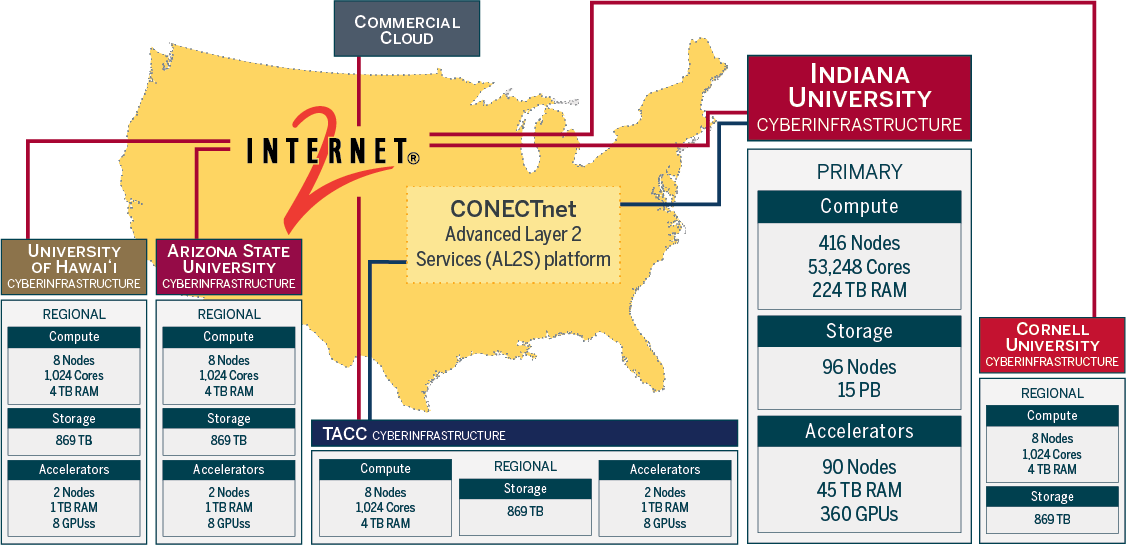Architecture and Capabilities of Jetstream2¶
Jetstream2 consists of one primary cloud and multiple regional clouds. As you can see by the image below, the primary cloud is hosted at Indiana University in Bloomington, IN with regional clouds at various institutions across the United States.
How do Jetstream domains and Jetstream2 regions differ?
Another huge distinction is that instead of different domains – default (Atmosphere) and tacc (API) domains, there is one namespace for Jetstream2. You can change between the CLI, Horizon, Exosphere, and Cacao as you see fit to manage your resources

Allocations will only be awarded on the primary cloud by default.
Hardware¶
Jetstream2 brings multiple classes of research computing hardware. Jetstream2 still has hundreds of CPU-based compute nodes for general purpose virtual machines/computing. Jetstream2 also features a small number of large memory nodes with up to 1 terabyte of RAM. Jetstream2 makes available 90 GPU-enabled nodes with four NVIDIA A100 GPUs each. These are subdivided using NVIDIA virtual GPU (vGPU) to allow Jetstream2 allocations to utilize from 1/5th of a GPU to an entire GPU in their instances, facilitating everything from educational use requiring a minimal amount of GPU processing power to a full GPU for research workloads.
Interfaces¶
Jetstream2 features an interface called Exosphere as the primary, recommended GUI interface. Jetstream2 also provides API services utilizing both the OpenStack Horizon GUI and a robust command-line interface (CLI). Atmosphere has evolved into a new tool called Containerized Atmosphere for Continuous Analysis Orchestration (CACAO or simply Cacao), which is built on the principles of Atmosphere (abstracting complicated functions such as firewalls and virtual networking). Because Jetstream2 will no longer have separate operating domains for Cacao and API operations, those utilizing Jetstream2 can switch between interfaces easily, seeing all virtual machines and other assets created in any interface. This single namespace also allows for third-party interfaces that can manage any OpenStack created resource to be used with Jetstream2.
Containers and Orchestration¶
Jetstream2 is bringing support for containers to the forefront of services. It will support managing and scaling container-based workloads via the cloud-native functionality of OpenStack Magnum or using standalone Kubernetes deployments. Users will be able to deploy Docker Swarm, Apache Mesos, or Kubernetes container orchestration engines to manage and run their container-based research workloads. In addition, the features of Cacao will provide similar functionality to individuals who have no desire to access the OpenStack API directly. Both approaches allow researchers and educators to scale their workloads dynamically according to their needs.
Additional Services¶
Services such as OpenStack Heat will be available for researchers and developers, as well. OpenStack Heat is a service that allows individuals to instantiate complex resources with dependencies via a declarative YAML-based language. Further, tools such as HashiCorp’s Terraform programmable infrastructure, with the ability to deploy on Jetstream2, private clouds, and commercial clouds easily and consistently, will allow developers and researchers to have their environments where they need, when they need it. These capabilities build on one of the fundamental aspects of cloud computing: the ability of users to create, manage, and orchestrate use of tools autonomously, based on need, without involving sysadmins to install or enable new software.
Virtual Clusters¶
In addition to the ability for individuals to control their infrastructure programmatically, Jetstream2 provides the capability to spin up elastic HPC virtual clusters (VCs) at the push of a button. These have been tested extensively on Jetstream1, with about thirty VCs running in production at different times. These Slurm-powered virtual clusters allow individuals to transition easily between cloud and HPC resources, acting as both a test-bed environment for custom software, and a highly-available production resource for projects with modest computational needs. The deployment process for these resources in Jetstream2 will be streamlined, allowing individuals to deploy an instance, acting as a head node, that is ready to accept jobs. Once jobs are submitted, worker instances will be automatically created and destroyed as needed. The Singularity/Apptainer container runtime environment will be built into these VCs, allowing individuals to use containerized scientific software without lengthy installation processes.
Info
Push-button virtual cluster deployment is available in Exosphere now.
Historical Reference¶
Jetstream1 utilized two primary clouds, geographically dispersed and powered by OpenStack, to provide thousands of concurrent virtual machines to researchers, educators, and students from hundreds of institutions across the United States. Jetstream1 featured Atmosphere, a user-friendly graphical user environment, as the means of access for the majority of users. Jetstream1 also allowed API access for infrastructure-driven projects like science gateways.
There are quite a few similarities between Jetstream1 and Jetstream2. Jetstream2 will be powered by a more recent version of OpenStack and will still have a primary mission of providing virtual machine services to research and education faculty, staff, and students. Jetstream2, however, will build on what Jetstream1 delivered and provide a number of improvements and new services.